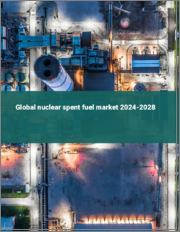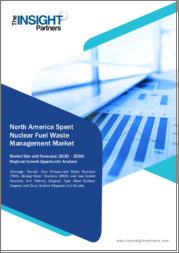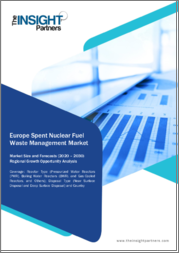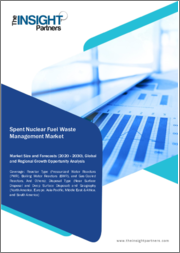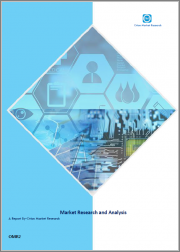
|
시장보고서
상품코드
1327638
세계의 핵폐기물 관리 시스템 시장(2023-2030년)Global Nuclear Waste Management System Market 2023-2030 |
||||||
세계 핵폐기물 관리 시스템 시장은 예측 기간 동안 연평균 2.1%의 높은 성장률을 보일 것으로 예상됩니다. 방사성 물질의 배출을 제한하는 엄격한 기준과 규제는 세계 핵폐기물 관리 시스템 시장의 성장을 촉진하는 주요 요인입니다. 세계원자력협회(World Nuclear Association)에 따르면, 민간 원자력 산업에서 발생하는 고준위방사성폐기물(HLW)의 양은 적습니다. 국제원자력기구(IAEA)의 추정에 따르면, 최초의 원자력 발전소가 가동된 이후 39만 2,000톤의 중금속(tHM)이 사용후핵연료 형태로 배출되었습니다. 이 중 127,000tHM이 재처리된 것으로 IAEA는 추정하고 있으며, IAEA는 현재 고체 HLW 재고의 처분량은 약 29,000m3로 추산하고 있습니다.
원자력 발전은 모든 폐기물에 대해 전적으로 책임을 지고 이를 제품에 완전히 비용으로 계상하는 유일한 대규모 에너지 생산 기술입니다. 모든 종류의 민간 방사성 폐기물을 관리할 수 있는 재정적 준비가 되어 있습니다. 원자력 발전소의 폐기물 관리 및 처리 비용은 일반적으로 발전된 전력의 총 비용의 약 5.0%를 차지합니다. 대부분의 원자력 발전 사업자는 폐기물 관리 및 처분을 위해 정부로부터 부과금(예: 미국에서는 킬로와트시당 0.1센트, 프랑스에서는 1kWh당 0.14센트)을 징수해야 합니다.
부문별 전망
저준위 폐기물이 세계 핵폐기물 관리 시스템 시장에서 큰 비중을 차지
저준위방사성폐기물(LLW)은 1톤당 4기가베크렐(GBq/t)의 알파 방사능 또는 1톤당 12GBq/t의 베타-감마 방사능을 초과하지 않는 방사성 물질을 함유하고 있으며, 취급 및 운송 시 차폐가 필요하지 않아 지표면 근처의 시설에 처분하기에 적합합니다. LLW는 핵연료주기뿐만 아니라 병원과 산업계에서도 발생합니다. 종이, 헝겊 조각, 공구, 의류, 필터 등으로 구성되며 주로 수명이 짧은 방사능을 소량 함유하고 있습니다. 부피를 줄이기 위해 LLW는 종종 압축하거나 소각한 후 폐기하는 경우가 많습니다.
핵폐기물의 90.0% 이상이 LLW로 분류되기 때문에 방사성 폐기물을 적절하고 안전하게 보관하기 위해 더 많은 인프라가 필요합니다. 또한, 원자력 발전이 깨끗하고 지속가능한 에너지원으로 각광을 받으면서 많은 국가들이 원자력 발전소 및 관련 시설에 투자하고 있으며, 이는 LLW의 효과적인 관리에 대한 수요를 촉진할 것으로 예상됩니다.
지역별 전망
세계 핵폐기물 관리 시스템 시장은 북미(미국 및 캐나다), 유럽(이탈리아, 스페인, 독일, 프랑스, 기타), 아시아태평양(인도, 중국, 일본, 한국, 기타), 기타 지역(중동 및 아프리카, 라틴아메리카) 등 지역별로 세분화됩니다. 아시아태평양은 세계 핵폐기물 관리 시스템 시장에서 상당한 성장을 보일 것으로 예상됩니다.
북미, 세계 핵폐기물 관리 시스템 시장에서 상당한 점유율을 차지
북미 지역은 세계 핵폐기물 관리 시스템 시장에서 큰 비중을 차지하고 있습니다. 원자력 관리 시스템 설계 및 메커니즘을 강화하기 위한 파트너십과 협업의 확대는 이 지역의 시장 성장을 촉진하는 중요한 요인입니다. 예를 들어, 2023년 2월, 토론토 대학교 연구진은 핵폐기물관리기구(NWMO)와 협력하여 사용 후 핵연료 패키지를 처리하기 위한 새로운 플랜트 설계 및 레이아웃을 최적화했습니다. 다학제적 설계 최적화로 알려진 기술을 활용하여 이 프로젝트는 캐나다의 사용후 핵연료의 장기적인 관리를 더욱 강화하는 것을 목표로 하고 있습니다. 이 지역 전역의 주요 기업의 존재는 이 지역의 시장 성장에 더욱 기여하고 있습니다.
목차
제1장 보고서 개요
- 업계 현황 분석과 성장 가능성 전망
- 조사 방법과 툴
- 시장 내역
- 부문별
- 지역별
제2장 시장 개요와 인사이트
- 조사 범위
- 애널리스트의 인사이트와 현재 시장 동향
- 주요 조사 결과
- 추천사항
- 결론
제3장 경쟁 상황
- 주요 기업 분석
- Fluor Corp.
- 개요
- 재무 분석
- SWOT 분석
- 최근의 동향
- Veolia Environnement SA
- 기업 개요
- 재무 분석
- SWOT 분석
- 최근의 동향
- Westinghouse Electric Company LLC
- 개요
- 재무 분석
- SWOT 분석
- 최근의 동향
- 주요 전략 분석
제4장 시장 세분화
- 핵폐기물 관리 시스템 세계 시장 : 폐기물 유형별
- 저레벨 폐기물
- 중간 레벨 폐기물
- 고레벨 폐기물
- 핵폐기물 관리 시스템 세계 시장 : 원자로 유형별
- 가압수형 원자로
- 비등수형 경수로
- 가압수형 중수로
- 가스냉각로
- 기타
- 핵폐기물 관리 시스템 세계 시장 : 최종사용자별
- 유틸리티
- 산업용
제5장 지역 분석
- 북미
- 미국
- 캐나다
- 유럽
- 영국
- 독일
- 이탈리아
- 스페인
- 프랑스
- 기타 유럽
- 아시아태평양
- 중국
- 인도
- 일본
- 한국
- 기타 아시아태평양
- 세계 기타 지역
제6장 기업 개요
- Agence Nationale pour la gestion des dechets radioactifs(ANDRA)
- Augean PLC
- Bechtel Corp.
- BHI Energy
- Cabrera Services Inc.
- Chase Environmental Inc.
- Enercon Services Inc.
- EnergySolutions Inc.
- Fluor Corp.
- Holtec International Corp.
- JGC Corp.
- Orano SA
- Perma-Fix Environmental Services Inc.
- Stericycle Inc.
- Studsvik AB
- US Ecology Inc.
- Veolia Environment SA
- Waste Control Specialists LLC
- Westinghouse Electric Company LLC(Toshiba)
Title: Global Nuclear Waste Management System Market Size, Share & Trends Analysis Report Market by Waste Type (Low-level Waste, Intermediate-level Waste, and High-level Waste), by Reactor Type (Pressurized Water Reactor, Boiling Water Reactor, Pressurized Heavy Water Reactor, Gas Cooled Reactor, and Others), and by End-User (Utility and Industrial)Forecast Period (2023-2030).
The global nuclear waste management system market is anticipated to grow at a considerable CAGR of 2.1% during the forecast period. The stringent standards and regulations to limit radioactive emissions is a key factor driving the growth of the global nuclear waste management system market. According to World Nuclear Association, the volume of high-level radioactive waste (HLW) produced by the civil nuclear industry is small. As per the estimation of the International Atomic Energy Agency (IAEA), 392,000 tones of heavy metal (tHM) in the form of used fuel have been discharged since the first nuclear power plants commenced operation. Of this, the agency estimates that 127,000 tHM have been reprocessed. The IAEA estimates that the disposal volume of the current solid HLW inventory is approximately 29,000 m3.
Nuclear power is the only large-scale energy-producing technology that takes full responsibility for all its waste and fully costs this into the product. Financial provisions are made for managing all kinds of civilian radioactive waste. The cost of managing and disposing of nuclear power plant waste typically represents about 5.0% of the total cost of the electricity generated. Most nuclear utilities are required by governments to put aside a levy (e.g. 0.1 cents per kilowatt hour in the US, 0.14 ¢/kWh in France) to provide for the management and disposal of their waste.
Segmental Outlook
The global nuclear waste management system market is segmented based on waste type, reactor type and end-user. Based on waste type, the market is segmented into low-level waste, intermediate-level waste, and high-level waste. Based on reactor type, the market is segmented into pressurized water reactor, boiling water reactor, pressurized heavy water reactor, gas cooled reactor, and other. Based on end-user, the market is sub-segmented into utility and industrial.
Low-level Waste Holds a Considerable Share in the Global Nuclear Waste Management System Market
Low-level waste (LLW) has a radioactive content not exceeding four giga-becquerels per ton (GBq/t) of alpha activity or 12 GBq/t beta-gamma activity. LLW does not require shielding during handling and transport, and is suitable for disposal in near surface facilities. LLW is generated from hospitals and industry, as well as the nuclear fuel cycle. It comprises paper, rags, tools, clothing, filters, etc., which contain small amounts of mostly short-lived radioactivity. To reduce its volume, LLW is often compacted or incinerated before disposal.
As more than 90.0% of nuclear waste comes under the LLW category, more infrastructure is needed to store the radioactive waste properly and safely. Moreover, as nuclear power is getting popular due to clean and sustainable sources of energy, various countries are investing in nuclear power plants and related facilities, which is expected to drive the demand for the effective management of LLW.
Regional Outlook
The global nuclear waste management system market is further segmented based on geography, including North America (the US and Canada), Europe (Italy, Spain, Germany, France, and others), Asia-Pacific (India, China, Japan, South Korea, and others), and the Rest of the World (the Middle East & Africa and Latin America). Asia-Pacific is anticipated to exhibit considerable growth in the global nuclear waste management system market.
North America Held Considerable Share In the Global Nuclear Waste Management System Market
North America held considerable share in the global nuclear waste management system market. Growing partnership and collaboration to enhance the design and mechanism of nuclear power management system is a key factor driving the regional market growth. For instance, in February 2023, the researchers at the University of Toronto have collaborated with the Nuclear Waste Management Organization (NWMO) to optimize the design and layout of a new plant for processing used nuclear fuel packages. By leveraging a technique known as multidisciplinary design optimization, the project aims to further enhance Canada's long-term management of used nuclear fuel. The presence of key players across the region is further contributing to the regional market growth.
Market Players Outlook
The major companies serving the global nuclear waste management system market include: Fluor Corp., Bechtel Corp., Westinghouse Electric Company LLC, Veolia Environment SA, and Perma-Fix Environmental Services, Inc., among others. The market players are considerably contributing to the market growth by the adoption of various strategies, including mergers and acquisitions, partnerships, collaborations, funding, and new product launches, to stay competitive in the market. For instance, in January 2023, Ghana has joined a pilot project done by IAEA for the disposal of sealed radioactive sources. The disposal facilities will bring the country close to its nuclear power ambitions.
The Report Covers:
- Market value data analysis of 2022 and forecast to 2030.
- Annualized market revenues ($ million) for each market segment.
- Country-wise analysis of major geographical regions.
- Key companies operating in the global nuclear waste management system market. Based on the availability of data, information related to new product launches, and relevant news is also available in the report.
- Analysis of business strategies by identifying the key market segments positioned for strong growth in the future.
- Analysis of market-entry and market expansion strategies.
- Competitive strategies by identifying 'who-stands-where' in the market.
Table of Contents
1. Report Summary
- Current Industry Analysis and Growth Potential Outlook
- 1.1. Research Methods and Tools
- 1.2. Market Breakdown
- 1.2.1. By Segments
- 1.2.2. By Region
2. Market Overview and Insights
- 2.1. Scope of the Report
- 2.2. Analyst Insight & Current Market Trends
- 2.2.1. Key Findings
- 2.2.2. Recommendations
- 2.2.3. Conclusion
3. Competitive Landscape
- 3.1. Key Company Analysis
- 3.2. Fluor Corp.
- 3.2.1. Overview
- 3.2.2. Financial Analysis
- 3.2.3. SWOT Analysis
- 3.2.4. Recent Developments
- 3.3. Veolia Environnement SA
- 3.3.1. Overview
- 3.3.2. Financial Analysis
- 3.3.3. SWOT Analysis
- 3.3.4. Recent Developments
- 3.4. Westinghouse Electric Company LLC
- 3.4.1. Overview
- 3.4.2. Financial Analysis
- 3.4.3. SWOT Analysis
- 3.4.4. Recent Developments
- 3.5. Key Strategy Analysis
4. Market Segmentation
- 4.1. Global Nuclear Waste Management System Market by Waste Type
- 4.1.1. Low-level Waste
- 4.1.2. Intermediate-level Waste
- 4.1.3. High-level Waste
- 4.2. Global Nuclear Waste Management System Markey by Reactor Type
- 4.2.1. Pressurized Water Reactor
- 4.2.2. Boiling Water Reactor
- 4.2.3. Pressurized Heavy Water Reactor
- 4.2.4. Gas Cooled Reactor
- 4.2.5. Others
- 4.3. Global Nuclear Waste Management System Market by End-User
- 4.3.1. Utility
- 4.3.2. Industrial
5. Regional Analysis
- 5.1. North America
- 5.1.1. United States
- 5.1.2. Canada
- 5.2. Europe
- 5.2.1. UK
- 5.2.2. Germany
- 5.2.3. Italy
- 5.2.4. Spain
- 5.2.5. France
- 5.2.6. Rest of Europe
- 5.3. Asia-Pacific
- 5.3.1. China
- 5.3.2. India
- 5.3.3. Japan
- 5.3.4. South Korea
- 5.3.5. Rest of Asia-Pacific
- 5.4. Rest of the World
6. Company Profiles
- 6.1. Agence Nationale pour la gestion des dechets radioactifs (ANDRA)
- 6.2. Augean PLC
- 6.3. Bechtel Corp.
- 6.4. BHI Energy
- 6.5. Cabrera Services Inc.
- 6.6. Chase Environmental Inc.
- 6.7. Enercon Services Inc.
- 6.8. EnergySolutions Inc.
- 6.9. Fluor Corp.
- 6.10. Holtec International Corp.
- 6.11. JGC Corp.
- 6.12. Orano SA
- 6.13. Perma-Fix Environmental Services Inc.
- 6.14. Stericycle Inc.
- 6.15. Studsvik AB
- 6.16. US Ecology Inc.
- 6.17. Veolia Environment SA
- 6.18. Waste Control Specialists LLC
- 6.19. Westinghouse Electric Company LLC (Toshiba)








